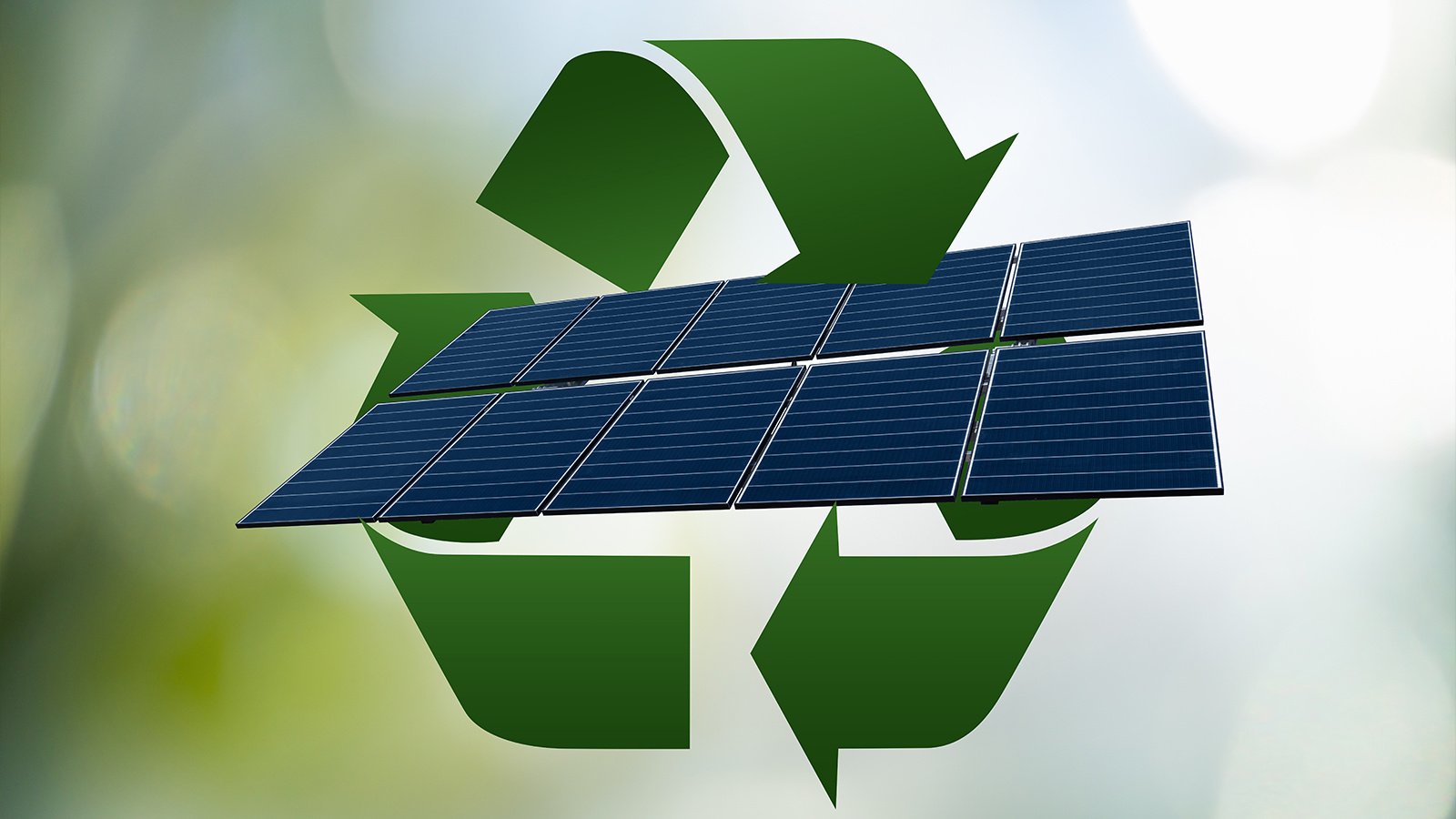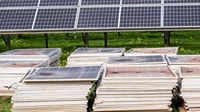The solar energy industry is booming, but what happens to solar panels at the end of their lifecycle? Exploring the potential in solar panel reuse and recycling could be the key to a more sustainable future.
The Growing Need for Solar Panel Recycling
As the adoption of solar energy continues to rise, the imperative to address the end-of-life of solar panels becomes increasingly significant. With millions of solar panels installed globally, a substantial volume will eventually reach their end-of-life phase in the coming decades.
Just how substantial, you may ask? In the latest EnergyBin Insights webinar, we shared an estimate from the International Renewable Energy Agency (IRENA) that states a current solar panel waste volume of 9 million modules. In 5 years, that number will increase to 26 million, and by 2050, there will be an estimated 2.25 trillion solar panels at their 30-year end-of-life.
These numbers point to the opportunity for a robust system for recycling these panels.
The sheer volume of waste from decommissioned solar panels could become a substantial environmental issue if not properly managed. Governments and industries are starting to recognize this impending challenge and the need for sustainable solutions.
Environmental and Economic Benefits of Reusing and Recycling Solar Panels
Reusing and recycling solar panels offer both environmental and economic advantages. From an environmental perspective, reuse cuts down on premature disposals and conserves on energy needed to strip modules in the recycling process. Recycling helps to reduce landfill waste and prevents potential soil and water contamination from hazardous materials found in some panels. It also conserves valuable resources such as glass, metals, and photovoltaic materials, which can be repurposed for new panels or other applications.
Economically, reuse and recycling hold the potential to generate a new market - what we like to call the "secondary market" - and create job opportunities.
The aforementioned substantial volume of end-of-life solar panels anticipated by IRENA makes the business case for a healthy recycling market. But this estimate doesn't account for panels that come offline prior to the 30-year mark. Of course, some panels that are prematurely decommissioned today are damaged beyond repair, and therefore are slated for recycling. Others, however, are in near mint condition and nowhere near ready for retirement.
Opportunities for reuse boil down to whether a viable resale value exists. On EnergyBin, approximately 7% of modules listed for resale are used. That accounts for about 500,000 modules that have been remarketed on our wholesale exchange. In the global market, we've observed large lots of secondhand modules for sale direct to consumers via online marketplaces and auction sites. Even eBay and Craigslist host used panel listings.
Generally, wholesale sellers and resellers remarket used solar panels on EnergyBin that are 5-10 years old, contain minimal to no blemishes, have degradation rates at or below the industry standard, and are 300 watts or higher. The current global price of new modules, which has been hitting around $0.08-0.15 per watt this year due to oversupply, has overshadowed the size and profitability of the secondary solar market.
Yet, from our perspective, we've seen many wholesale buyers (installers, EPCs, developers, and O&M companies) seeking RFQs for replacement modules in the 300-400 watt range. Oftentimes, they are more concerned with finding replacements with exact dimensions than whether the product is new or refurbished.
Additionally, we could see an increase in early decommissions as asset owners and investors take advantage of new, higher wattage modules at lower costs to repower their arrays. Power optimization is one of the primary reasons why solar companies list used modules for sale on EnergyBin. They've chosen to replace their current modules with new modules and want to recoup some of the cash invested in the old, which may be as young as 1-5 years, as we've seen from some sellers. Buyers benefit from this situation by snagging quality modules at a discounted rate, modules that likely have a minimum of 20-25 years of power output left.
With respect to recycling, the reprocessing of materials from old panels can supply raw materials for new products, reducing the need for mining and refining virgin materials. According to the IEA-PVPS Report, End-of-Life Management: Solar Photovoltaic Panels, the cumulative value of recoverable raw materials from end-of-life panels could exceed $15 billion by 2050.
Likely, the market value for both reuse and recycling is conservatively stated today.
Innovative Technologies in Solar Panel Recycling
The development of innovative technologies is essential to improve the efficiency and effectiveness of solar panel recycling. Current methods include mechanical, thermal, and chemical processes to separate and reclaim valuable materials from decommissioned panels. For instance, mechanical recycling involves shredding the panels and separating different components through processes like magnetic separation and eddy current separation.
Additionally, researchers are exploring advanced techniques such as laser ablation and acid leaching to recover high-purity silicon and other critical materials. These innovative technologies not only enhance the recovery rates but also reduce the environmental impact of the recycling process itself.
Challenges and Solutions in the Solar Panel Recycling Industry
Despite the clear benefits, the secondary solar market faces several challenges. One major issue is the economic viability of recycling processes, as the cost of recycling often exceeds the value of the recovered materials. Furthermore, the lack of standardized recycling protocols and infrastructure can hinder the growth of the industry.
Solutions to these challenges include third-party certification programs, government policies, and incentives to support reuse and recycling efforts. Global standards, such as the R2 Certification, help to establish a hierarchy of reuse over recycling, as well as ensure responsible recycling when PV hardware is ready for full retirement. Additionally, investment in research and development can lead to more cost-effective and efficient recycling technologies. And of course, the market itself will provide some level of cost correction as more volume comes into play leading to economies of scale for efficient recycling companies.
Future Prospects and Opportunities in Solar Panel Reuse and Recycling
The future of solar panel reuse and recycling holds great potential. As the industry matures, the establishment of a circular economy for solar panels can significantly contribute to sustainability goals. Emerging business models, such as leasing solar panels with end-of-life take-back options, can further promote reuse and recycling.
There are also opportunities for international collaboration to develop global standards and best practices for solar panel recycling. Product tracking and data sharing, including product use and performance history, would do well to strengthen a global network of resellers and recyclers. It would also ensure that unwanted solar waste is not exported for resale when it should rather be recycled. By working together, stakeholders can share knowledge, technology, and resources to create a more sustainable and efficient secondary market that encompasses reuse and recycling solutions.
What does this all mean for your business? Looking at the big picture, solar isn't going away any time soon. Every major industry, including technology, has a robust secondary market that provides reuse and recycling solutions as well as a plethora of value-added services to meet customer needs. Although the secondary solar market may be in its infancy, the opportunities are there for the taking and will only grow with the industry.
One practical next step we'd recommend is to start small. Many EnergyBin member companies are operating in both the primary and secondary markets, where repair, resale, decommissioning, and/or recycling services are a percentage of their overall revenue portfolios. Some have shared their stories with us about how they got into secondary solar market activities, like The Solar Recycling Company whose parent company is an ITAD veteran with decades of experience in data tape media reuse and recycling. If you're in tune with what your customers want, chances are you'll discover opportunities to reuse and recycle flowing from your own customer base.
More Resources
 Resell or Recycle: A Guide for Handling Used Solar Panels
Resell or Recycle: A Guide for Handling Used Solar Panels


 How Resellers Can Avoid Buying & Selling Solar Panel Waste
How Resellers Can Avoid Buying & Selling Solar Panel Waste